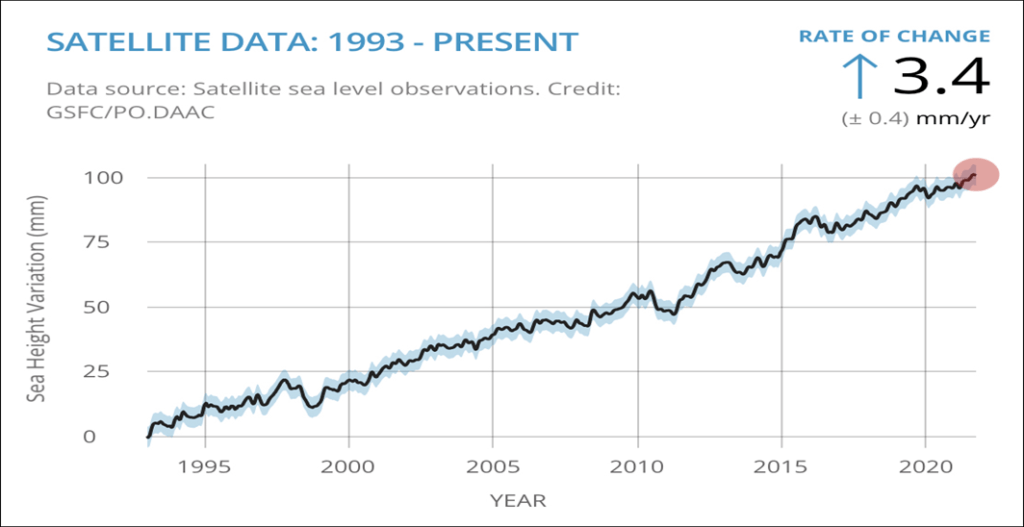The World Meteorological Organisation (WMO) recently released its ‘State of the Global Climate 2022’ report, revealing that sea levels are rising at an unprecedented rate. This has the potential to lead to disastrous consequences for the weather, agriculture, the existing groundwater crisis, and social disparities. In addition to rising sea levels, the report focused on a consistent rise in global temperatures, record-breaking increases in greenhouse gas concentration, glacier loss, sustained drought-like conditions in East Africa, record rainfall in Pakistan, and unprecedented heatwaves that struck Europe and China in 2022.

The Rate of Sea-Level Rise
To calculate the rate of change in the Global Mean Sea Level (GSML), the difference in the GSML across a few years can be calculated, and the difference can then be divided by the number of years. The report shows that the rate of sea-level rise was 2.27 mm/year in 1993-2002 but shot up to 4.62 mm/year in 2013-2022, which is a doubling of the rate of sea-level rise.

Causes of Accelerated Sea-Level Rise
Ocean warming contributed 55% to the accelerated sea-level rise, and the loss of glaciers and ice sheets contributed 36% between 2005-2019. As increasing concentrations of greenhouse gases, such as carbon dioxide, drive global warming, 90% of the ‘extra’ heat is stored in the oceans. This leads to ocean warming, which undergoes thermal expansion and results in a rise in the GSML. Another factor is the earth’s ice cover, which has thinned, leading to a loss of glaciers and ice sheets. Changes in the storage of land water contributed less than 10%.
Concerns
- Rising sea levels can lead to a shortage of land cover, particularly in coastal areas.
- Coastal communities may face an acute shortage of land for human use, leading to an increase in social disparities between people living in coastal areas.
- Weather formations such as cyclones typically originate in the open seas, and as the GSML continues to rise, the chances of cyclones could increase.
- Cyclones could affect coastal communities and lead to significant economic liabilities for tropical countries such as India and South Africa, which have high population densities.
- As the GSML continues to rise, more sea water could seep into the ground, leading to the groundwater turning more saline.
- This could exacerbate water crises in coastal areas as well as agriculture in adjacent regions.
- The lives of coastal communities, including their economic activities, are tied intricately with the coastal ecosystem.
- Changes in the coastal ecosystem as a result of GSML rise will further endanger the socio-economic stability of these communities.
About WMO
The World Meteorological Organization (WMO) is a specialized agency of the United Nations that is responsible for promoting international cooperation on atmospheric science, climatology, hydrology, and geophysics. The WMO is made up of 193 countries and facilitates the free and unrestricted exchange of data, information, and research between the respective meteorological and hydrological institutions of its members. The WMO is governed by the World Meteorological Congress, composed of member states, and meets every four years to set policies and priorities. The WMO annually publishes a statement on the status of the World Climate.
Why In News
The latest report from the World Meteorological Organization (WMO) reveals that the rate of sea-level rise is reaching unprecedented levels, which could have disastrous effects on weather patterns, agriculture, groundwater, and exacerbate social inequalities.
MCQs about Unprecedented Sea Level Rise
-
According to the ‘State of the Global Climate 2022’ report, what is the cause of the accelerated sea-level rise?
A. Ocean warming
B. Changes in land water storage
C. Ice loss from snow cover
D. None of the above
-
What has been the trend in the rate of global mean sea-level (GSML) rise in the past two decades?
A. It has remained constant
B. It has decreased
C. It has doubled
D. It has decreased and then increased
-
What could be a potential consequence of the rising sea level for coastal communities?
A. Shortage of land
B. Increase in available land
C. Decrease in salinity of groundwater
D. Decrease in economic activities
-
What is the primary responsibility of the World Meteorological Organization (WMO)?
A. Promoting international cooperation on atmospheric science, climatology, hydrology and geophysics
B. Regulating international trade
C. Promoting international cooperation on finance and economics
D. Regulating international human rights
Boost up your confidence by appearing our Weekly Current Affairs Multiple Choice Questions
![]()


